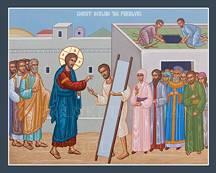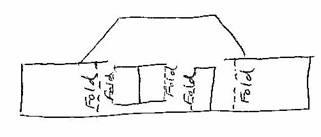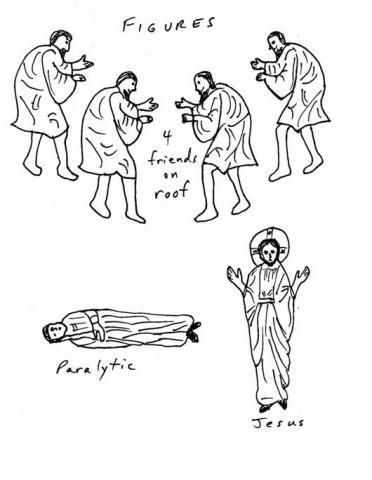Forgiveness and the Paralytic
FORGIVENESS/ THE PARALYTIC

Objectives:
- Students should be able to tell the story of the paralytic and his four friends.
- Students should know that Jesus can forgive sins because He is God.
- Students should know that we receive forgiveness from God through Confession and from each other on Forgiveness Sunday.
Possible Lesson Plan:
- Open with prayer.
- Scripture References: Luke 5: 17-26, Matthew 9:1-8, Mark 2:1-12. What does “paralytic” mean? Where was Jesus? Where were the friends with the man? How did they get into the house? What did Jesus do? Say? What happened? How do you think the man felt? His friends?
- Who forgives sins? Jesus said something unusual to the paralytic before he healed him. What did He say? The paralytic hoped for healing for his body. But Jesus first healed his soul. The Prodigal Son asked for forgiveness; did the paralytic? Tonight, in church, we’ll be celebrating Forgiveness Sunday. We’ll go from one to another asking forgiveness and being forgiven. Remind the students how the service will proceed and have them pair up to practice. But, only one person can forgive us all our sins. Who is that? When Jesus told the paralytic that his sins were forgiven, Jesus was claiming to be Whom? And, when the paralytic walked, Jesus proved that He was indeed God!
Through which of our Sacraments do we receive forgiveness from God?
(Confession) Why can’t we just confess in secret to God? (What about that pervasive self-deceiving psychological trick, denial, and accountability?) Who does the priest represent? (Christ) Did Jesus have the authority to forgive sin? (Consider the healing of the paralytic) What was the practice of the earliest Christians? (They actually stood up before the whole congregation and confessed their sins, truly walking in the light.) Why did this practice end and priests begin to hear confession privately? (Strangers coming to visit as the Church grew in numbers made public confession difficult.)
- Play a learning game: Charades. Write the names of several miracles we have already studied on slips of paper – Feeding the 5000, walking on water, quieting the storm, water into wine, paralytic, transfiguration. Each student in turn should choose a paper and act out the miracle so the others can guess what it is.
 Make a Stand-up House and add the paralytic, Jesus, and his friends. The house is easily made with a long sheet of construction paper. Cut out window and door, folding to open. Cut out the figures and color them. Glue or tape the friends to the roof, each one holding a string that attaches to one corner of a piece of felt for the stretcher of the paralytic. The strings should be just long enough that the paralytic, lying on his “stretcher” is visible in the window. Glue Jesus in the doorway.
Make a Stand-up House and add the paralytic, Jesus, and his friends. The house is easily made with a long sheet of construction paper. Cut out window and door, folding to open. Cut out the figures and color them. Glue or tape the friends to the roof, each one holding a string that attaches to one corner of a piece of felt for the stretcher of the paralytic. The strings should be just long enough that the paralytic, lying on his “stretcher” is visible in the window. Glue Jesus in the doorway.
6. We are now entering Lent. Use the Lenten Path to trace your journey through the season.
7. Close with prayer.
